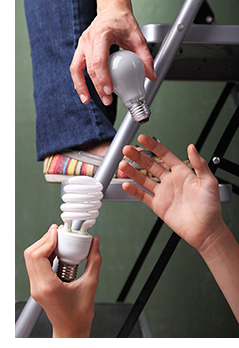 |
|||||
| Spring 2014 | |||||
Call 811 so you can dig safely |
|||||

After a long snowy winter, springtime is finally here. It’s a time for planting the garden and trees, putting up a fence, and maybe even building a pool or deck. There’s one very important thing you should remember about any type of digging project: Call 811 before you dig If you accidentally hit an underground line when digging, it can cause many different problems. If a gas line is struck, this can cause a gas leak, which might turn into a fire hazard or interrupt gas service for the whole neighborhood. If you strike an underground power line, you could get a serious shock or cause a power outage. Hitting a water line could cause flooding and damage to your home. Sometimes you might not even be aware that you’ve struck an underground line. But just a small crack, dent, or scrape in the line can create big trouble. It can cause a slow leak or a short circuit that might become a problem later on. So it’s better to be safe than sorry. Whether it’s you, an adult, or a building contractor, remember: Call 811 before you dig. 
What happens when you call 811? In a day or two, the utilities will send a worker to mark the location of the underground lines, pipes, and cables. When you know what’s below the surface, you can dig safely.
When should you call? By calling ahead, you can make sure there are no injuries, shocks, property damage, power outages, or service interruptions for you and others. It makes sense to take the proper precautions for any type of digging project, no matter who is doing it. | |||||
April is National Safe Digging Month |
|||||
Use of wind power began |
|||||

Although the use of wind turbines to produce electricity has become very popular in the past few years, taking advantage of wind energy is nothing new. Thousands of years ago, man discovered the power of the wind and how it can be used. The first known use of wind energy was around 7,000 years ago when boats used sails to travel along the Nile River in Africa. Several thousand years later, simple windmills were built in Asia to pump water and grind grain. No one really knows how these windmills worked because there are no drawings or designs to explain this early technology. By 1100, the use of windmills was widespread in the Middle East, a part of Asia where merchants from Europe would travel to buy certain types of food and other products. The merchants not only took Middle Eastern food back with them, but they also spread the word about windmills and all the wonderful things they could do. In the 1300s, the Dutch people, many of whom lived close to the ocean, used windmills to help drain flooded lands. People all over the world continued to use wind energy for pumping water, grinding grain, and other farm tasks. Wind power used for electricity In 1931, the first large wind turbine was built in Russia but there wasn’t much interest in wind power until about 40 years later. At most power plants, coal and oil were being used to produce electricity. These fuels were in great supply and were also inexpensive. Back then, no one knew about air pollution and global warming. Wind turbines become popular In the next several decades, we also learned about the harmful effects of burning coal, oil, and gas in power plants. Scientists learned that one of the best ways to reduce pollution and climate change was to use renewable energy sources, like wind and water power. Today, thousands of years after man first discovered wind power, we’re still finding better ways to harness wind energy.
|
|||||
Teamwork doesn’t just apply |
|||||

There are many situations where you need to be part of a team to get something done. It can be a sports team, a school project team, a Boy or Girl Scout troop, or volunteering for an organization. Creating a team to do any type of project is more complicated than just doing it yourself, but it has many advantages. That’s because each individual can contribute something a little bit different. So a team can produce lots of new ideas and different approaches. When you add everyone’s contributions together, it can really be exciting to see how much can be accomplished. A team also gives its members an opportunity to concentrate on one specific area. It can be something you’re really good at, something you want to learn about, or something you like. You don’t have to worry about doing the whole project. You can just focus on your part. For example, let’s say your teacher divides the class into three-person teams and the project is to create a science poster. One person can do the research, another can organize the design, and the third team member can do the drawing and lettering. |
|||||
Leadership Communication Support Responsibility Being successful as a team can require more work but it’s a very exciting and satisfying experience when you work together to achieve a common goal. |
|||||
CFLs and LEDs save energy, |
|||||
Why are more people using CFLs and LEDs? Because they save energy and have many other benefits, too. Let’s start with the energy savings. CFLs and LEDs save electricity According to ENERGY STAR®, a government agency that studies the efficiency of appliances and other household items, each CFL saves about $6 a year in electricity costs. An LED saves slightly more. That might not seem like a lot but when you consider that the average home has more than 40 light bulbs, the savings really add up. CFLs and LEDs save time LED bulbs last even longer, about three times more than CFLs and up to 50 times longer than incandescent lights. If you spend three minutes changing a bulb, you can save several hours a year by switching to CFLs or LEDs. CFLs and LEDs run cooler Cooler-running CFLs and LEDs are also safer because there’s less of a chance to accidentally start a fire. 
CFLs and LEDs save money Although LEDs are more expensive than compact fluorescent bulbs, they are quickly becoming very popular. In addition to saving energy, LEDS are more durable, less sensitive to temperature, and last about three times longer. In addition, LEDs turn on more quickly. More than 70 percent of all light sockets in the country are still using incandescent bulbs. If we can get each homeowner to switch just a few bulbs each year to CFLs or LEDs, there would be a tremendous amount of energy savings.
|
|||||
Explore our world of energy education… |
|||||
| If you can’t see this email, click here. | #9763 © 2014 Culver Media, LLC |






 Because working as a team is complicated, there are some important things you need to remember.
Because working as a team is complicated, there are some important things you need to remember.
 More and more homes are using compact fluorescent lights (CFLs) and light-emitting diode (LED) bulbs than ever before. CFLs and LEDs are specially-designed light bulbs that save energy. Many of them have a design that is quite different from regular incandescent light bulbs, but fit standard light bulb sockets nonetheless.
More and more homes are using compact fluorescent lights (CFLs) and light-emitting diode (LED) bulbs than ever before. CFLs and LEDs are specially-designed light bulbs that save energy. Many of them have a design that is quite different from regular incandescent light bulbs, but fit standard light bulb sockets nonetheless.